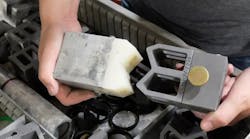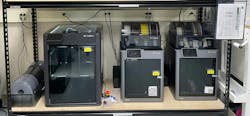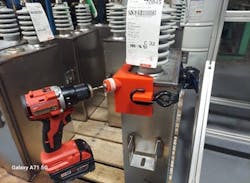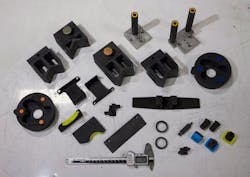You’re Calculating the Value of Additive Wrong
Key Highlights
- Eaton successfully integrated additive into operations worldwide.
- Instituting strict governance made adoption faster and more efficient.
- Plant-led procurement creates buy-in and inspires more immediate use of the technology.
- A database of shared print files could exponentially increase additive's value for operators.
Cameron Peahl never thought his efforts to disseminate, standardize and operate additive technology efficiently for an organization with over 200 plants spread across 35 countries would bear so much fruit.
“Anytime our printers are down, it impacts the business,” says Peahl, manager for industry 4.0 and global AM strategy at industrial equipment giant Eaton. “I was blown away the other day when I got an email that a site’s 3D printer wasn’t working, and we were holding up a production line because they couldn’t print the fixtures that they needed to print to keep the line going. Never in my wildest dreams did I think that a 3D printer would hold up production.”
Additive manufacturing worked its way organically into the company, says Peahl, with the first organized efforts begun in 2011 by Eaton's vehicle group. Serious conversations about the technology’s value took place in 2013 and 2014 as plants increasingly leveraged printers.
This led to the founding of the Additive Manufacturing Center of Excellence (AMC) in suburban Detroit in 2016. The AMC’s work quickly made clear that aerospace was a perfect fit for additive manufacturing. The center became the industrialization hub to kickstart the roadmap for aerospace production.
With a background in manufacturing and developing quality systems for aerospace, Peahl joined the AMC in 2018 and took his leadership role in 2020. His group experiments with new additive techniques such as cold spray, materials qualification and work parameter development. On the practical side, the AMC supports additive in Eaton’s factories that print tools, jigs and fixtures to support operations.
“We’ve been manufacturing for 120 years at Eaton. We’re not going to teach anybody how to manufacture something. Our factories are good. So, to [deploy additive] efficiently, we’ve approached it from a global governance perspective,” Peahl says.
Making Additive Easy for Everyone
Peahl sits at the head of a global committee established in 2022 of fourteen leaders from businesses across Eaton. The committee agrees on strategy, what additive technology they’ll deploy and how. Committee members then have their own committees within their respective businesses, attended by Eaton plant leadership.
“It elevates our leaders so they can help direct what’s going to be important to their own businesses and really be the voice to the factories and from the factories, with the lens of their own businesses priorities,” Peahl says.
Governance in this case means sanctioning official hardware that Eaton supports with EHS guidance, IT assistance and setting up portals for materials purchases from approved vendors.
“When a site buys a 3D printer, they have the documentation that they need. When that machine lands in a factory they can plug it in and go. Every day that thing sits waiting for safety to bless it or IT to connect it is money lost, and that just makes everyone angry and against additive,” Peahl says.
Five years ago, he says, allowing plants to choose their own 3D printers made more sense because of the amount of new hardware hitting the market. The additive industry was in its Wild West period.
“The last count that I had prior to [instituting global governance] we had something like 340 printers across Eaton, covering like 70 different makes and models,” Peahl says.
Now, he says, the industry has matured. With 3D printers from Bambu Lab, Formlabs and Markforged, there’s little a factory can’t do in terms of operations support, so why not stick with proven technologies?
“What we want our engineers to do is be creative and problem-solving with these mature, trustworthy technologies and not wasting their time tinkering with parameters and settings and all that other garbage and nonsense…. When we need something in a factory, we want to print what we want when we want it, not fiddle with jams and clogs [because then] this thing’s like a science project, not an industrial machine,” Peahl says.
Additive Is About Engagement
While Peahl can readily calculate additive manufacturing’s value for Eaton using traditional metrics, he thinks they miss the true value of adopting additive.
“The obvious value metric is cost savings, and that comes in two forms, cost out and cost avoidance. The problem that additive faces is you’re inherently making new things. [Businesses] love cost out…but if you have a metal fixture, you’re not going to just go print a plastic fixture just for funsies,” Peahl says.
The qualitative value metric, on the other hand, tallies time saved getting a machine working after it breaks down, because the plant could 3D print a replacement part. Or the time saved printing out new safety equipment when EHS standards change, rather than calling in the consultants. Or the feeling operators get when they can request a new tool, fixture or jig and have the item delivered to them in a fraction of the time it took before the plant installed a 3D printer.
“When I was a manufacturing engineer, an operator would come to me and say, ‘I need this fixture,’ or ‘I need this tool.’ I needed to CAD sketch that thing, go to the tool room, have the tool designer mock it up, and then get into tool queue. I wouldn’t get that thing for weeks or months. Then I’d go back to the operator. ‘Hey, remember you wanted this thing?’ And they’d say ‘That took forever. What the hell are you guys doing?’” Peahl says.
“[With quick additive turnaround] our operators feel heard and they’re getting the solutions they need. Now we have operators putting in requests for prints all the time, [developing] really good solutions and it’s this engagement factor that we never had before.”
Factories Need Skin in the Game
While Peahl’s group provides strict governance on which 3D printers Eaton approves for use in its plants, it does not provide the printers. That’s on individual plant managers. The question is one of incentive.
“When a plant manager has to choose between a [different] purchase…versus a buying a 3D printer, and they make that decision to buy that 3D printer because they realize it’s important to follow along with the corporate standards…the plant manager has ponied up that money and wants to see that ROI on that investment that he’s made into his business, so suddenly there is an incentive for that site to do good things additively,” Peahl says.
Earlier in Eaton’s additive journey, the company bought printers and sent them to plants, only for managers to ignore them because, “sites have other things to worry about and this new tech is not top of the list. So while it seems harsh [to make plants purchase their own 3D printers], they need skin in the game.”
Peahl says the plants that decided to go their own way and purchase 3D printers not on the approved list, and go it alone in terms of support, almost always admit to making a bad choice. There’s very little pushback on the need to stick within the boundaries of global governance, because it means having the newest technology and the fewest headaches trying to use it.
The Additive Problem You Want to Have
One advantage of getting so many plants onto the same printers is the ability to share designs between facilities. If one plant needed to design a fixture to solve a specific production issue, there’s a chance that another plant could use precisely the same fixture. And with so many plants adopting additive, Peahl faces a real challenge trying to manage and share all this data.
“What we really want is, there’s a website called Thingiverse, a publicly available repository for 3D models. Any of us who are DIYers and printers at home use Thingiverse. So our thought is, we need an Eaton Thingiverse so that we can search…what are other people doing for milling machines or injection molding machines?” says Eaton.
“I’ve got a manual assembly line. I need tool holders. What do I have for tool holders out there? I may not find exactly what I want, but at least I can pull that model down and customize it to my own needs, maybe? We’re looking at how AI can help us with this.”
About the Author
Dennis Scimeca
Dennis Scimeca is a veteran technology journalist with particular experience in vision system technology, machine learning/artificial intelligence, and augmented/mixed/virtual reality (XR), with bylines in consumer, developer, and B2B outlets.
At IndustryWeek, he covers the competitive advantages gained by manufacturers that deploy proven technologies. If you would like to share your story with IndustryWeek, please contact Dennis at [email protected].





